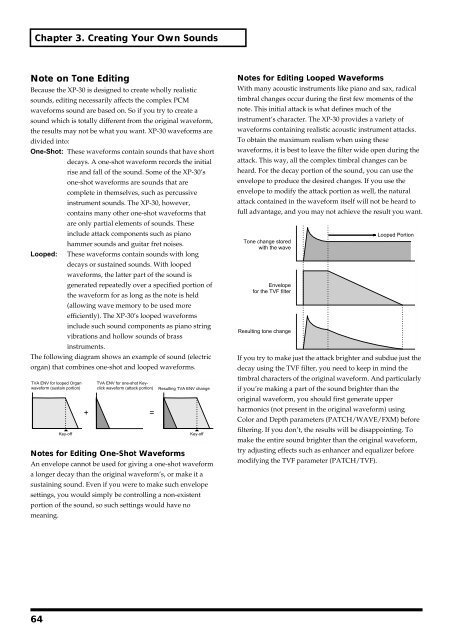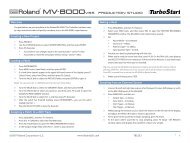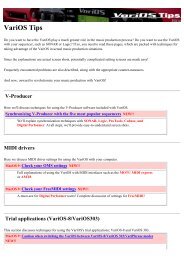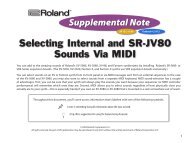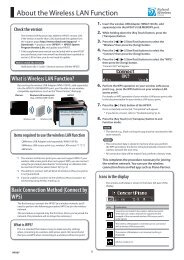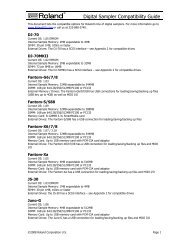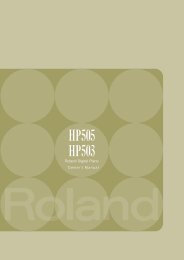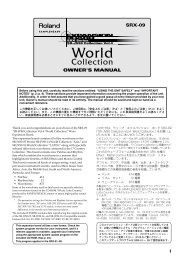Create successful ePaper yourself
Turn your PDF publications into a flip-book with our unique Google optimized e-Paper software.
Chapter 3. Creating Your Own Sounds<br />
Note on Tone Editing<br />
Because the XP-30 is designed to create wholly realistic<br />
sounds, editing necessarily affects the complex PCM<br />
waveforms sound are based on. So if you try to create a<br />
sound which is totally different from the original waveform,<br />
the results may not be what you want. XP-30 waveforms are<br />
divided into:<br />
One-Shot: These waveforms contain sounds that have short<br />
decays. A one-shot waveform records the initial<br />
rise and fall of the sound. Some of the XP-30’s<br />
one-shot waveforms are sounds that are<br />
complete in themselves, such as percussive<br />
instrument sounds. The XP-30, however,<br />
contains many other one-shot waveforms that<br />
are only partial elements of sounds. These<br />
include attack components such as piano<br />
hammer sounds and guitar fret noises.<br />
Looped: These waveforms contain sounds with long<br />
decays or sustained sounds. With looped<br />
waveforms, the latter part of the sound is<br />
generated repeatedly over a specified portion of<br />
the waveform for as long as the note is held<br />
(allowing wave memory to be used more<br />
efficiently). The XP-30’s looped waveforms<br />
include such sound components as piano string<br />
vibrations and hollow sounds of brass<br />
instruments.<br />
The following diagram shows an example of sound (electric<br />
organ) that combines one-shot and looped waveforms.<br />
fig.3-09.e<br />
TVA ENV for looped Organ<br />
waveform (sustain portion)<br />
Key-off<br />
TVA ENV for one-shot Keyclick<br />
waveform (attack portion)<br />
+ =<br />
Resulting TVA ENV change<br />
Key-off<br />
Notes for Editing One-Shot Waveforms<br />
An envelope cannot be used for giving a one-shot waveform<br />
a longer decay than the original waveform’s, or make it a<br />
sustaining sound. Even if you were to make such envelope<br />
settings, you would simply be controlling a non-existent<br />
portion of the sound, so such settings would have no<br />
meaning.<br />
Notes for Editing Looped Waveforms<br />
With many acoustic instruments like piano and sax, radical<br />
timbral changes occur during the first few moments of the<br />
note. This initial attack is what defines much of the<br />
instrument’s character. The XP-30 provides a variety of<br />
waveforms containing realistic acoustic instrument attacks.<br />
To obtain the maximum realism when using these<br />
waveforms, it is best to leave the filter wide open during the<br />
attack. This way, all the complex timbral changes can be<br />
heard. For the decay portion of the sound, you can use the<br />
envelope to produce the desired changes. If you use the<br />
envelope to modify the attack portion as well, the natural<br />
attack contained in the waveform itself will not be heard to<br />
full advantage, and you may not achieve the result you want.<br />
fig.3-10.e<br />
Tone change stored<br />
with the wave<br />
Envelope<br />
for the TVF filter<br />
Resulting tone change<br />
Looped Portion<br />
If you try to make just the attack brighter and subdue just the<br />
decay using the TVF filter, you need to keep in mind the<br />
timbral characters of the original waveform. And particularly<br />
if you’re making a part of the sound brighter than the<br />
original waveform, you should first generate upper<br />
harmonics (not present in the original waveform) using<br />
Color and Depth parameters (PATCH/WAVE/FXM) before<br />
filtering. If you don’t, the results will be disappointing. To<br />
make the entire sound brighter than the original waveform,<br />
try adjusting effects such as enhancer and equalizer before<br />
modifying the TVF parameter (PATCH/TVF).<br />
64


